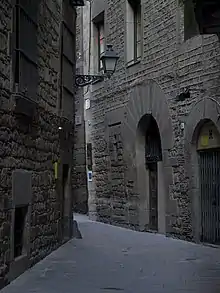41°22′56″N 02°10′37″E / 41.38222°N 2.17694°E

The Jewish quarter of Barcelona (Catalan: El Call de Barcelona, Spanish: Barrio Judío de Barcelona) in Barcelona, Spain, is an area located in the Gothic Quarter. The quarter was the heart of the city's Jewish community from the 7th to 14th centuries[1] and was one of the most important Jewish quarters on the Iberian Peninsula during the Middle Ages.[2]
Etymology
El Call means "little street" or "alley" in Catalan, and referred to the set of narrow streets that the Jews occupied. The broader self-governing community of Jews was called the aljama.[3]
History
Establishment of the Call
Small numbers of Jews arrived in Barcelona soon after 70 CE as part of the wave of migrants arriving in Europe fleeing Roman repression in Judaea during the First Jewish-Roman War. By 1079, the Jewish population in Barcelona numbered about 70 families.[3]
At the end of the 7th century, the Jewish population was enclosed in the Call, which formed around the Carrer del Call, Carrer de Sant Domènec del Call, Carrer Marlet, and Arc de Sant Ramón del Call.[1]
Growth and Golden Age (12th and 13th century)
Growth in El Call and the arrival of Jews who had been expelled from France by the 13th century made it necessary to expand the Jewish quarter, so the Call Menor, or Minor Call, was created, in addition to the Call Major or Major Call.[3]
By the 13th century, the Call was the largest in Catalonia. Medieval Barcelona was approximately 15% Jewish during its golden age, with most of the 4,000 Jews living in the Jewish quarter. Barcelona earned the reputation as a "city of sages" among the Jews.[4] The Jews worked as doctors, scientists, merchants, and money lenders for Catalan aristocracy. As only Jews could legally lend money, Jews became the official financiers of Catalonia's sovereigns.[1] Jews were officially property of the crown, and at the Fourth Lateran Council in 1215, papal instructions called for Jews to wear hoods and a red button sewn into their clothes to identify them. By 1268, King James I removed the requirement that the Jews in aljama had to wear the badge.[3]
Pogroms and Inquisition (14th and 15th century)
The Jews' situation in Barcelona worsened when Barcelona was hit by a run of famines beginning in 1333 and with the Black Death in 1348, which killed an estimated fifth of the city's population. Many blamed Jews, leading to an attack on the Jewish quarter in 1349.[3]
The Jewish quarter was hurt badly during Antisemitic mob violence on the quarter by a mob as part of the pogroms of 1391 across Spain. From the outbreak of violence on 5 August through 10 August, approximately 300 Jews were killed.[3]
During the Spanish Inquisition, the Jewish population in Barcelona was all but decimated. King Ferdinand ordered that the size of synagogues be no larger than the smallest Christian church.[5]
21st century
In the center of the Jewish quarter is the Ancient Synagogue, also called the Sinagoga Major, one of the oldest synagogues in Europe.[6] The synagogue is thought to have existed in some shape or form since the 5th century.[5] During the 1990s, the synagogue was restored and reopened to the public in 2003.[1]
Jewish community of Barcelona
An estimated 3,500 Jews reside in Barcelona in the 21st century, making it the largest concentration of Jews in Spain.[7]
References
- 1 2 3 4 "Jewish Quarter (Barcelona)". Fodor's. New York Times. 2008. Archived from the original on 28 January 2023. Retrieved 27 February 2023.
- ↑ "The Catalan Route – Barcelona". European Jewish Heritage. European Association for the Preservation and Promotion of Jewish Culture and Heritage. Archived from the original on 1 January 2023. Retrieved 27 February 2023.
- 1 2 3 4 5 6 Mora, Victoria. "El Call" (PDF). Museum of the History of Barcelona. Barcelona Institute of Culture. Archived (PDF) from the original on 29 January 2023. Retrieved 29 January 2023.
- ↑ Staff writer (15 October 2021). "The cultural legacy of the aljama". Museum of the History of Barcelona. Barcelona Institute of Culture. Archived from the original on 15 February 2023. Retrieved 15 February 2023.
- 1 2 Warner, Leah (13 January 2021). "El Call: The Jewish Quarter in Barcelona". CityLife Barcelona. Archived from the original on 28 January 2023. Retrieved 28 January 2023.
- ↑ Samuels, Justin (30 May 2018). "Old Synagogue Barcelona". Boulder Jewish News. Archived from the original on 13 March 2023. Retrieved 13 March 2023.
- ↑ "Barcelona". Jewish Heritage Alliance. 11 August 2017. Archived from the original on 28 January 2023. Retrieved 28 January 2023.